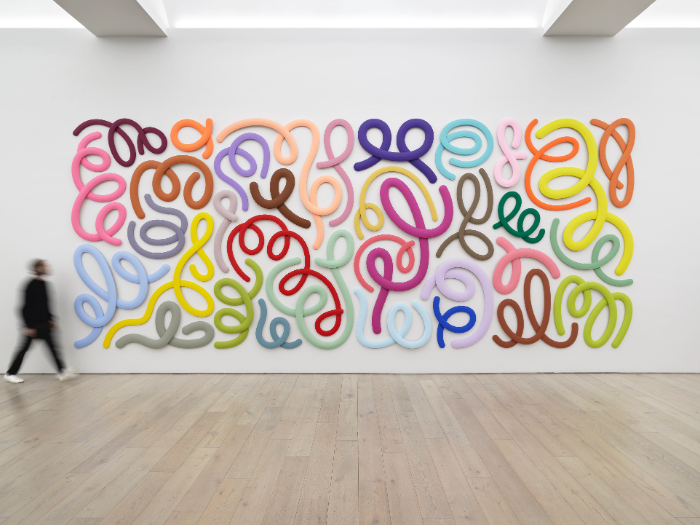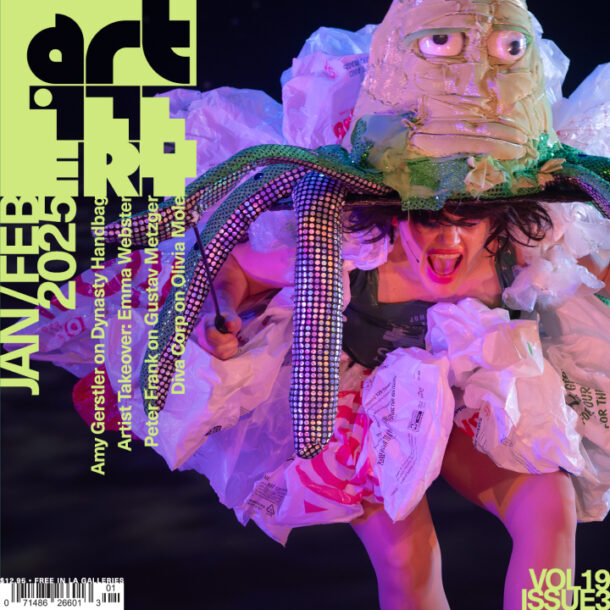
Perrotin Los Angeles is pleased to present Josh Sperling’s first solo exhibition on the West Coast, opening Saturday, May 31st. Known for his vibrant shaped canvases and interlocking forms, the American artist draws on influences from minimalist abstraction to Memphis design. This exhibition marks a significant evolution in his practice, featuring new paintings alongside his first foray into functional design in the United States, introducing modular benches and framed mirrors—extending his visual language beyond the canvas and into new contexts.
In Josh Sperling’s Big Picture, the devil is in the details. The first solo exhibition of the Ithaca-based artist in Perrotin’s Los Angeles space combines Sperling’s quintessential sculptural paintings, demonstrating a decade-long commitment to the mastery of form and color, and his recent exciting venture into design, as function wiggles its way into the artist’s core concerns. Sperling’s whimsical lexicon of technicolor undulating shapes comes alive with fresh energy through an immersive environment where art, design, and craft overlap. The exhibition’s cheeky title references LA’s renown as the hub of the film industry and the gallery’s transformation of the former Del Mar Theater into an exhibition space that features remnants of its past, including the marquee, ticket booth, and theater hall. Big Picture showcases a dynamic evolution in Sperling’s practice, highlighting his desire to work beyond the confines of the wall. Not only have his paintings grown more three-dimensional, literally popping off the wall and looping onto themselves, but he has translated his painting language into full-bodied design objects that turn functionality into aesthetic experiences.
A series of “Composites,” each a microcosm of juxtaposition, opens the show and sets the scene. Sperling mixes and matches sharp, flat planes with raised, curvilinear shapes in various textures and surface treatments, creating shifting linear perspectives and the illusion of motion, to animate the painted compositions. These paintings encompass an assortment of dualities that work in tandem rather than in opposition within Sperling’s overall practice: order and chaos, structure and looseness, and minimalism and maximalism. The “Composites,” elaborate power-clashing choreographies of form, color, and pattern, are an ideal introduction to the artist’s practice as they encapsulate many of his inspirations, like 1980s Memphis design, the road signs of LA, and minimalist paintings of the 1960s and 1970s.
Modularity is at the core of Sperling’s practice. So it is no surprise that he would extend this approach to furniture–a grown-up manifestation of his love for Legos as a child. Central to the first room is a collection of seven single and six two-person seats covered in vibrant Kvadrit wool. Sperling’s playful contemporary take on the clean lines of mid-century furniture builds upon the legacy of Pierre Paulin’s iconic geometric furniture from the 1960s. This work is a rainbow arrangement of the artist’s signature “bullseye” and “double bubble” motifs, as bulbous stools that fit together to make up a three-dimensional version of his “Double Bubble” paintings. Like Paulin, Sperling does not compromise artistic integrity for functionality. The stools are user-friendly and easily come apart, but when brought back together, they are more than the sum of their parts, forming an inviting and bold pinwheel that is aesthetically pleasing and facilitates social interaction. In fact, the design of the stools provides a visual cue that establishes a sense of connection and harmony.
As if comically large confetti had exploded from a cannon or someone had doodled with a box of giant crayons, one of Sperling’s characteristic, lavish full-wall painting installations welcomes visitors into the second room. The show’s title piece is the first conglomeration made up of only “Swoops.” It is easy to get lost among the cursive gestures–the ups, the downs–like a visual rollercoaster. The energy is palpable as each piece curls, coils, and springs to life. The spirited “Swoops” are metaphorical giggles, the uncontrollable sounds of joy that escape in quick, short bursts, cutting through the silence. Each “Swoop” perfectly nestles among the others, undoubtedly the outcome of obsessive arrangement and rearrangement. However, they are reconfigured anew and still fit together when they come apart (into four distinct sections).
Like the many “Squiggles” of Sperling’s career, the “Swoops” are stretched canvas paintings in an unconventional format. While the saturated single-hued surfaces let the form shine, they also produce a deceiving mirage of flatness. The light-hearted, candy-coated loop-the-loops give an aura of simplicity and organic freedom. Yet, they result from a complicated and methodical process of ideation, building, configuration, and installation.
While initially working with conventional painting formats, precisely because it did not require specialized equipment, Sperling, the son of an art teacher, woodworker, and ceramicist, could not deny that he cared most about the craft of building. He then intentionally complicated his process by incorporating machines to assist in constructing his armatures. The foundations of Sperling’s shaped paintings are intricate plywood structures engineered to contort and stack before they are covered with stretched canvas and then painted. With form at the forefront, he often works with grayscale paper maquettes to puzzle his compositions before adding color from the massive paint chart displayed in pots that occupy his studio’s floor. As it turns out, it takes a lot of planning and labor to make it look effortless.
Across the wall of “Swoops” is the most unexpected addition to Big Picture–a large installation of amoeba-like mirrors. Unlike the rest of the objects, which are painted or tufted in punchy colors, Sperling remains true to the materials with these. The frames of the mirrors alternate between ash and walnut woods, recalling Noguchi’s 1970 marble sculpture, The Opening, which demonstrated how to assemble a large sculpture using smaller components. This pattern also hints at the black-and-white lines of Memphis. The nearby serpentine bench worms its way like a path in Candyland through the room, echoing the segmentation of the mirrors. Like the furniture in the first room, this piece, featuring color-blocked components, underscores Sperling’s continued pursuit of modularity while conveying connectivity.
Like his father, Sperling is a wood-bender at heart. The mirrors more transparently reveal the structures hidden beneath the layers of paint in other works. This installation feels like a moment of reflection for the artist, literally and figuratively. While the natural wood mirrors mark a surprising shift, their installation celebrates the aesthetics that have defined Sperling for most of his career by amplifying the color eruption on the opposite wall when looking at the mirrors’ surfaces. Through the lens of design, Sperling transforms his beloved archetypes while also marking a return to his childhood, surrounded by craft. Big Picture offers a generative feedback loop that makes Sperling’s already layered practice more intricate, propelling his practice into a new dimension.

